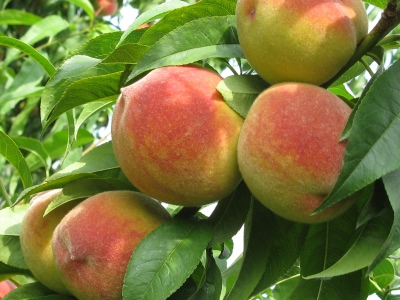
- Authors: Nikitsky Botanical Garden
- Growth type: medium-sized
- Ripening period: average
- Self-fertility: self-fertile
- Appointment: for fresh consumption, for canning, for making juices
- Yield: high
- Transportability: high
- Early maturity: begins to bear fruit in the 2-3rd year after planting
- Growing regions: all regions of the Russian Federation
- Bone size: small
In recent years, growing a peach tree has become easier and easier. This is due to the fact that there are many frost-resistant species that quickly adapt to the climate. One of these is the Sibiryak variety.
Breeding history
The mid-ripening peach variety Sibiryak is the result of many years of work by the Crimean breeders of the Nikitsky Botanical Garden. The main task of the scientists was to create a frost-resistant and fruitful variety that grows in any climatic zone. The fruit crop has been zoned in all regions of Russia, but it is the most productive, growing in the middle lane.
Description of the variety
Sibiryak is a medium-sized, fast-growing tree with a compact crown not exceeding 4 meters in diameter. Under favorable conditions, the peach grows to a height of 3-3.5 meters. The tree is characterized by medium thickening, light green foliage, a strong trunk with light gray bark and a developed root system. Outwardly, a peach tree sometimes resembles a large shrub with drooping elongated leaves and slightly spreading branches. Blossoming near the tree is observed in April-May. During this period, the crown is covered with beautiful pink flowers.
Fruit characteristics
Peach Sibiryak is a group of large-fruited species. The weight of a ripe fruit is 200-240 grams. The shape of the fruit is correct - rounded with a loose surface, on which a slight edge is noticeable. When ripe, peaches have a beautiful yellow-red color - a red-pink blush is clearly expressed on the yellow cover. Peach peels are of moderate density, non-uniform, without gloss.
The purpose of the fruits is universal - they are eaten fresh, used in cooking, processed and preserved. Once removed from the tree, peaches can be transported and stored for a long time under the right conditions - up to 20 days.
Taste qualities
This species is famous for its excellent taste. The pale yellow flesh has a slightly fibrous, tender, firm and very juicy texture. The fruit has a balanced taste - sweet, but without sugary, complemented by a pronounced dessert aroma. Inside there is a small bone that separates well from the pulp. Softening is slow.
Ripening and fruiting
The Siberian is endowed with medium ripening periods. The tree begins to bear fruit in the 2-3rd year after planting, continuing to bear fruit for 15 years. The mass ripening of peaches begins on August 10-14. The fruits ripen unevenly, therefore ripening is often delayed until the first days of September. Fruiting of the variety is stable and annual.
Yield
The yield indicators are quite high. As the tree grows, its yield increases. The average figure is up to 44 kg per tree per season. The first fruitful year is 20 kg of fruits, and in the 4th-5th year you can count on 50 kg of peaches.
Self-fertility and the need for pollinators
The variety is self-fertile, so it is not necessary to plant pollinating trees nearby.In practice, donor trees that provide cross-pollination have a positive effect on yields.
Growing and care
You can plant a crop both in spring and autumn - it all depends on the climatic conditions of the region. Optimal for planting is a one-two-year-old seedling with a developed root system and a trunk height of 100-150 cm. The site should not be located in lowlands to avoid moisture stagnation. Bad neighbors for peach are apple, cherry and pear, which can oppress the peach crop. Planting is carried out in the southern part of the selected site, where there are no compacted plantings of shrubs and trees.
Cultural agrotechnology consists of a whole chain of activities: watering, feeding, sanitary pruning of branches, crown molding, loosening and mulching of the soil, protection from viruses and insects.



Frost resistance and the need for shelter
Sibiryak is a winter-hardy culture, therefore it easily tolerates a drop in temperature to -20 ... 30 degrees. The tree does not need shelter.
Disease and pest resistance
Due to its high immunity, the culture rarely gets sick. The most common diseases that the tree still undergoes are clasterosporia, powdery mildew, leaf curl and fruit rot. The insects attacking the peach are aphids, moths, weevils and spider mites.

Requirements for soil and climatic conditions
A site with fertile, breathing loams that have a neutral acidity level is considered favorable for planting. The seedling should have enough heat and sun, and it is also necessary to provide protection from drafts.
































































